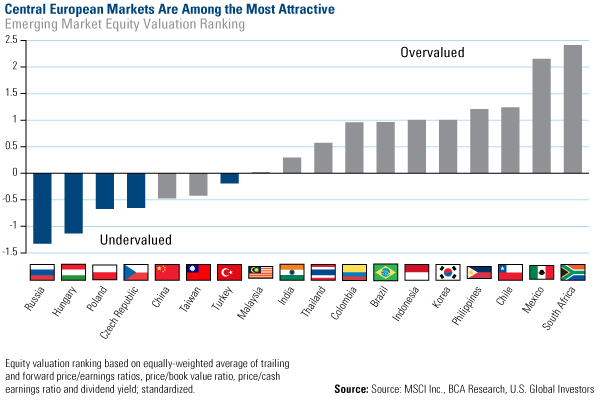Emerging Markets Radar (October 21, 2013)
Strengths
- This week a Bloomberg special report highlighted that emerging market technology stocks are at an all-time high, exceeding the highs reached during the dot-com bubble in 2000. The chart above shows the MSCI Emerging Markets Information Technology Index climbed to a new record, surpassing the previous all-time high in March of 2000. There is additional comfort in holding these stocks today given that the index is currently valued at 2.1 times net assets, much more conservatively than its multiple of 6.6 times in March 2000, notes Bloomberg. In addition, since the dot-com crash, technology stocks have turned from speculative bets into profitable companies that benefit from growing demand for online services and smartphones.
- Polish industrial output rose 6.2 percent from a year earlier in September, accelerating from 2.2 percent the previous month, thus posting the second-fastest increase since January 2012. This could be a sign that recovery in the European Union’s economy is gathering pace. Despite a portion of the higher output being attributed to an extra working day in September, the data still shows clear signs of improvement.
- China’s third quarter GDP growth was 7.8 percent and in line with the market expectation. Industrial production was up 10.2 percent, also in line with the market expectation. Retail sales growth for the month was strong at 13.2 percent, though slightly lower than the market expectation of 13.5 percent. Fixed asset investment was up 20.2 percent for the year, slightly lower than the market expectation of 20.3 percent. This data looks particularly strong given that China is in the process of transforming the economic structure from investment driven to consumption based, and also from low-end manufacturing to high-end manufacturing and technology driven. More significantly, consumption sectors now count for 45.5 percent of the economy, which is larger than 45.3 percent for investment and manufacturing sectors, evidence of success in rebalancing.
- China’s new bank loans for September were Rmb 787 billion versus the consensus of Rmb 675 billion and Rmb 711 billion in August. Money supply (M2) growth was 14.2 percent and in line with the market expectation. Total social financing (TSF) softened to Rmb 1.4 trillion from Rmb 1.57 trillion in August, due to a drop of new non-discounted bills, with year-over-year growth of outstanding TSF at 20.4 percent. Overall it is a stable monetary policy, likely without easing but also without tightening.
- Passenger vehicle sales in China went up 25 percent in September and up17.3 percent for the year-to-date period. The auto sales momentum could continue into the fourth quarter. China heavy truck sales also saw acceleration by 59 percent in September due to improving demand in construction and transportation.
- China’s rail freight volume growth improved to 8.1 percent in September from 8.0 percent in August, and was up 3.2 percent month-over-month.
- Overseas workers remittance in the Philippines was up 6.8 percent in August.
Weaknesses
- The Russian economy will post GDP growth of nearly zero in the third quarter this year, Deputy Economic Development Minister Andrei Klepach said at a meeting of the State Duma’s budget committee. Mr. Klepach added that the 1.8 percent economic growth estimate for this year is now an optimistic one, given that an extrapolation of the current tendency is more indicative of 1.5 to 1.6 percent growth in GDP.
- Mexico's ANTAD retail business association said on Monday that same store sales fell 6.2 percent in September from a year earlier. The association includes the retail chains Walmex and Soriana, as well as other department stores.
- Brazilian central bank's economic activity index rose only 0.08 percent in August from July, missing the median analysts' estimate of 0.2 percent growth in a Reuters’ survey. After modest acceleration in the second quarter, the Brazilian economy is struggling to maintain steady growth. Persistent high inflation hurt industrial competitiveness and led to a 200 basis point increase in the benchmark rate over the last five months.
- China’s September exports were down 0.3 percent due to a high base in the same period last year, as well as slowing trade growth with the United States, the European Union and South Korea. The market had expected trade growth of 5.5 percent in the month. Currency depreciation in the ASEAN countries along with Rmb appreciation affected China’s trade growth as well. Nevertheless, imports were up 7.4 percent, better than the market expectation of 7 percent, due to robust domestic demand.
- China’s September consumer price index (CPI) was 3.1 percent, higher than market expectation of 2.8 percent and 2.1 percent in August, due to food price inflation caused by hot weather and flooding in southern China. However, prices of industrial materials improved to -1.3 percent versus the market expectation of -1.4 percent and -1.6 percent a month ago, showing slower destocking.
Opportunities
- Emerging European equity markets are poised for a string of outperformance versus the emerging markets benchmark. After many years of underperformance, the forces of mean reversion could produce a period of medium-term outperformance for these stocks. According to BCA Research, the valuation ranking of emerging European equities provides these markets with an important margin of safety against negative surprises, compared with many other emerging markets. In addition, the majority of emerging European nations show improving external balances, suggesting that these economies are much less reliant on foreign savings for economic growth. This should help emerging European economies outperform in times of diminished appetite for emerging market assets.
- Russia aims to more than double its information technology (IT) exports to $11 billion by 2020, up from this year’s IT exports which are now approaching $5 billion to a decrease in the economy’s dependence on commodity exports, notes the Telecommunications Ministry. Deputy Minister Mark Shmulevich stated that the Telecommunications Ministry will support joint projects by Russian scientific institutes and local IT companies to develop technologies such as speech and video-image recognition, robotics, cyber-security and cloud services, as seen in the strategy.
- As shown in the chart above, the birth rate in China has gone up since 2011 due to the vast base of those who were born in the 1980s and were of child-bearing age. China’s one-child policy will soon be adjusted since many believe that the policy is creating a demographic burden as the population ages. This could be the beginning of a rising demographic cycle in China, which will bode well for child-targeted products.
Threats
- Asia’s exporters are failing to benefit from a recovery in advanced nations. As China’s exports unexpectedly fell last month, overseas shipments from Taiwan and South Korea also declined, according to Bloomberg. Asia’s export-led growth engine is showing signs of exhaustion, according to Frederic Neumann, Co-Head of Asian Economic Research at HSBC. Neumann argues that disappointing trade data may be evidence of a loss in competitiveness. As Europe emerges from its longest recession on record, and manufacturing grows in the U.S. at the strongest pace in more than two years, one could expect export-driven economies to become direct beneficiaries. However, the region’s export recovery appears to be faltering.
- HSBC Emerging Markets Research published a report this week showing consumer staples in Latin America are expensive and over-owned, following outperformance in the recent past. HSBC believes we are at a juncture when investors should be prepared to pay less for defensive sectors, especially consumer staples, as growth differentials narrow and the risk-free rate rises. Hence, the consumer staples sector is the largest underweight in its Latin American model portfolio, while the global cyclicals sector is the largest overweight.
- China has shown strong GDP growth in the third quarter, with powerful property sales as one of the drivers. Strong sales of auto, home appliance and furniture are correlated with property sales. If the government curbs price increases in the housing market, those sectors could be affected.


















